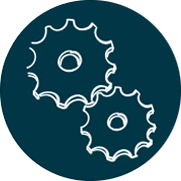Schools listed below are offering the courses in the 2025-2026 school year and are not a guarantee of future offerings.
Introductory Courses
From SBCC Course Catalog:
Catalog Course Description: Introduction to sciences (biology, chemistry, computer science, earth sciences, engineering, geography, mathematics, physics) and their interdependence. Discussion of scientific method through project-based activities, testing of hypotheses, systematic questioning and analysis. Basic concepts of the sciences, the role of science as a human endeavor and the power of scientific inquiry. Careers in sciences and educational planning. This course is currently offered to students enrolled in the Dos Pueblos Engineering Academy.
Transfer Information: CSU Transferable, UC Transferable
212 - Machining and Forming Technologies
Level: 1
Year: 1
Intro Course Required: No
Offered At: DPHS
Concentrator Courses
Kinetic Art, Sculpture, and Design utilizes a dynamic model of learning in which the classroom is a collaborative work environment, and students explore artistic endeavors whose design solutions rely on -- and benefit from -- the intersection of art and technology. Students will have access to sophisticated manufacturing and forming technologies, and they will utilize actuators, microcontrollers, sensors, and other electronics and electro-mechanical components as they develop their artistic creations.
Building upon the principles of design and engineering technology, students will explore and research novel ways to implement the elements of art and aesthetics. They will add content to their personal digital portfolios throughout the course, documenting their processes and pieces through images and written reflections. For their culminating project, students will create a kinetic sculpture that will include electro-mechanical elements, and utilize a microcontroller, actuators, and sensors in order to create an interactive experience for the viewer.
At the conclusion of this course, students will have showcased their final sculpture in a professional gallery and will have compiled a comprehensive body of work in their personal digital portfolios that highlights both process and product, with special attention given to the effect and impact of incorporating technology into art.
Kinetic Art, Sculpture, and Design utilizes a dynamic model of learning in which the classroom is a collaborative work environment, and students explore artistic endeavors whose design solutions rely on -- and benefit from -- the intersection of art and technology. Students will have access to sophisticated manufacturing and forming technologies, and they will utilize actuators, microcontrollers, sensors, and other electronics and electro-mechanical components as they develop their artistic creations.
Building upon the principles of design and engineering technology, students will explore and research novel ways to implement the elements of art and aesthetics. They will add content to their personal digital portfolios throughout the course, documenting their processes and pieces through images and written reflections. For their culminating project, students will create a kinetic sculpture that will include electro-mechanical elements, and utilize a microcontroller, actuators, and sensors in order to create an interactive experience for the viewer.
At the conclusion of this course, students will have showcased their final sculpture in a professional gallery and will have compiled a comprehensive body of work in their personal digital portfolios that highlights both process and product, with special attention given to the effect and impact of incorporating technology into art.
Capstone Courses
This college-level course provides students with the opportunity to participate in authentic experiential learning in the manufacturing engineering field. Students will leverage their extensive knowledge from their prior engineering, design, and product development courses to work with clients as they manufacture, assemble, test, and deploy a real product into service.
During this course students will engage in a professional manufacturing engineering process in which they will learn a variety of manufacturing skills in order for them to produce a finished product that is ready for deployment. At the conclusion of the course, students will present their process and work product to a client for review.
This college-level course provides students with the opportunity to participate in authentic experiential learning in the manufacturing engineering field. Students will leverage their extensive knowledge from their prior engineering, design, and product development courses to work with clients as they manufacture, assemble, test, and deploy a real product into service.
During this course students will engage in a professional manufacturing engineering process in which they will learn a variety of manufacturing skills in order for them to produce a finished product that is ready for deployment. At the conclusion of the course, students will present their process and work product to a client for review.
This college-level course provides students with the opportunity to participate in authentic experiential learning in the manufacturing engineering field. The course deepens the skills and knowledge of an engineering student within the context of efficiently creating the products all around us. Students use Computer Aided Design (CAD) experience through the use of Computer Aided Manufacturing (CAM) software. CAM transforms a digital design into a program that Computer Numerical Controlled (CNC) mills, 3D Printers, and laser cutting machines use to transform raw material into a product designed by a student for a professional customer.
This college-level course provides students with the opportunity to participate in authentic experiential learning in the manufacturing engineering field. The course deepens the skills and knowledge of an engineering student within the context of efficiently creating the products all around us. Students use Computer Aided Design (CAD) experience through the use of Computer Aided Manufacturing (CAM) software. CAM transforms a digital design into a program that Computer Numerical Controlled (CNC) mills, 3D Printers, and laser cutting machines use to transform raw material into a product designed by a student for a professional customer.
